It's been a strange week here! Raccoons left in plastic tubs, cat-caught bunnies, a random wood duck?
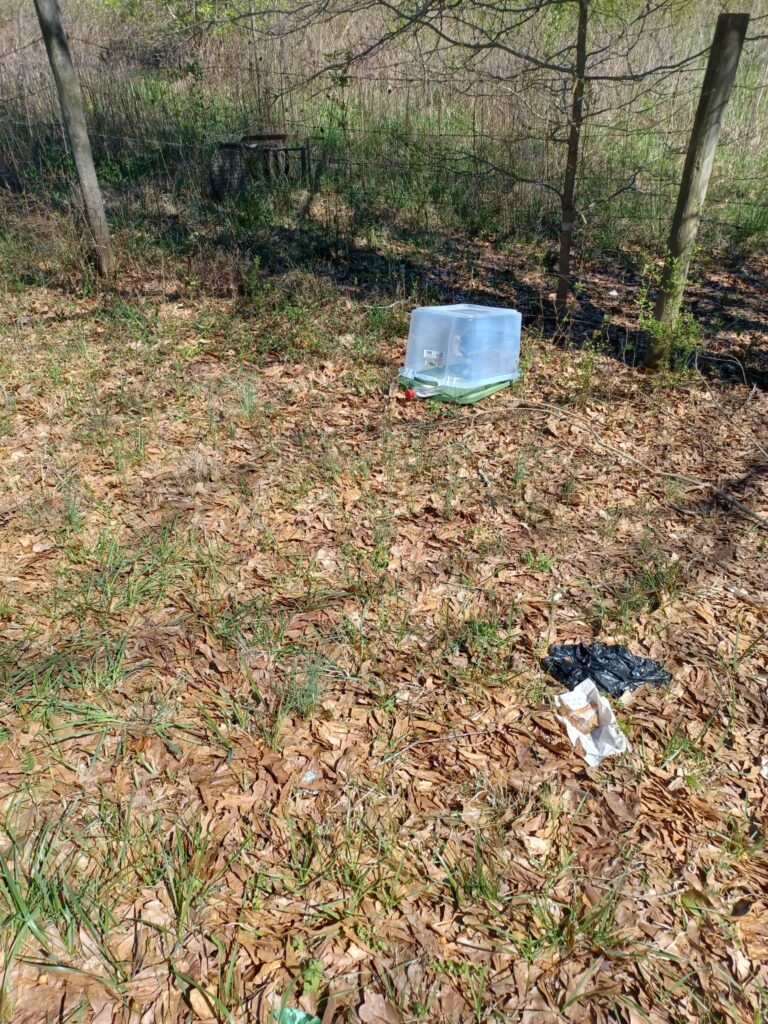
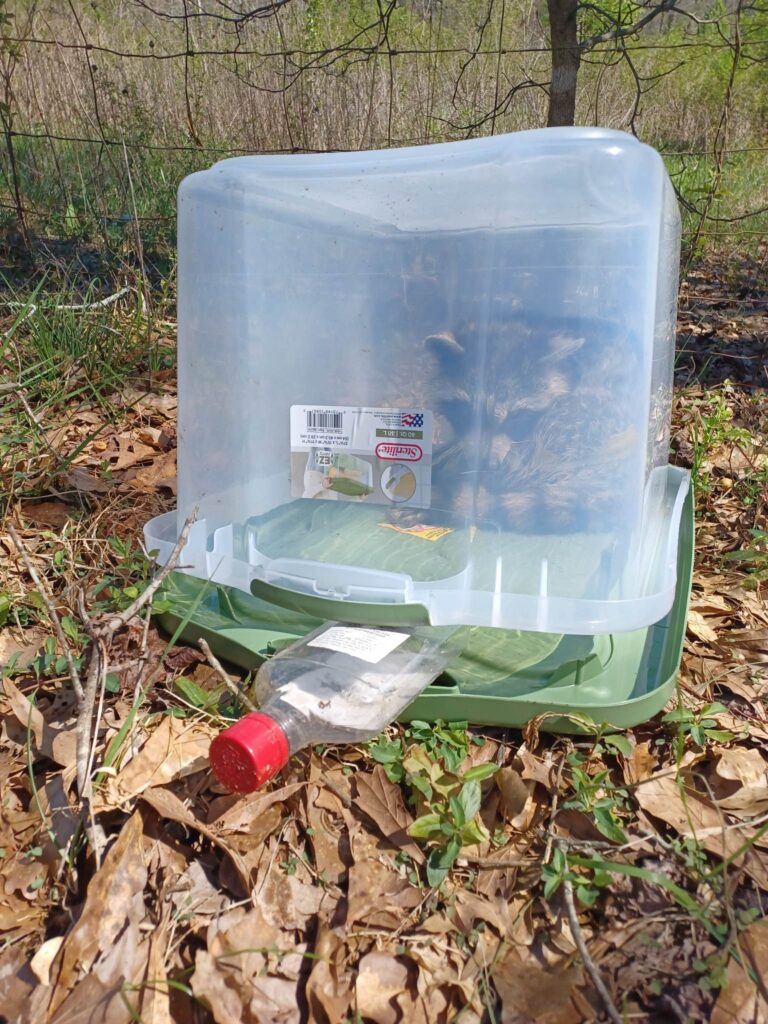
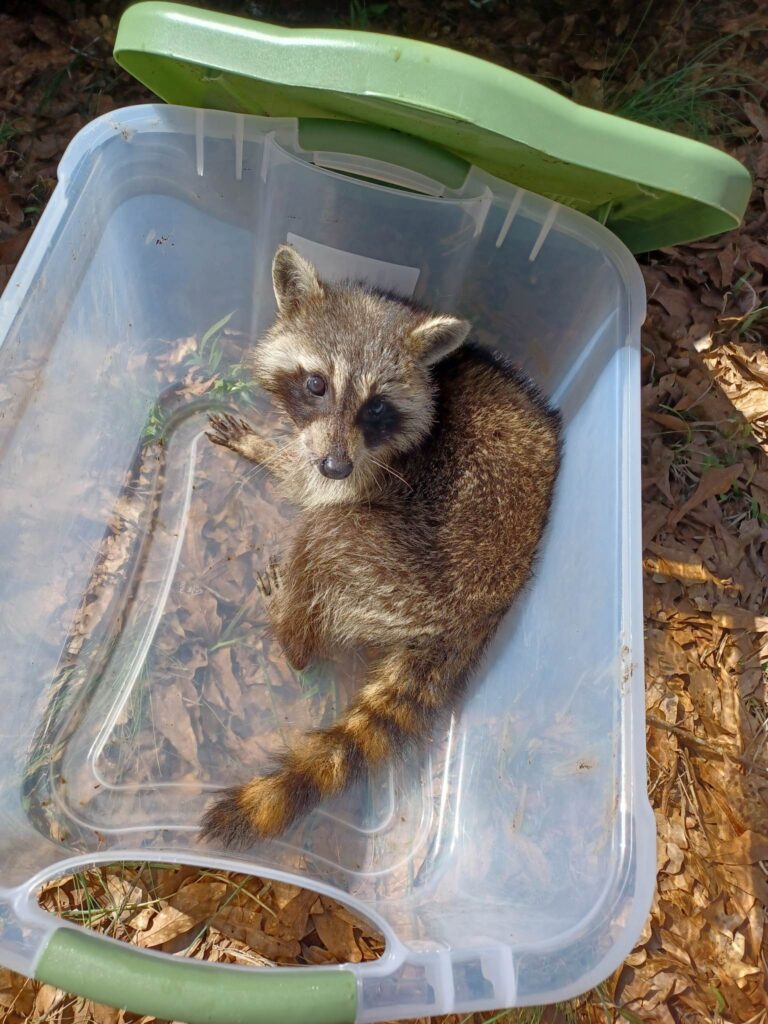
Raccoon in a tub
I got a call about a raccoon who was found sitting with his head down by the side of the road in a suburban neighborhood.
That posture usually means the animal has been hit by a car. The finder didn’t want him wandering back into the road so she used the lid of a plastic tub to scoop him up, then closed the lid (he had plenty of air).
Now what?
Not knowing what to do, and not finding anyone to help, she ended up leaving him in the tub, by the side of a rural road, 10 miles away. Luckily she had written down fairly good directions as to where to find him.
How I got involved
I couldn’t leave him there once she reached me and I learned of his predicament and I decided to make the 45 minute drive. You can see in the middle photo that he looks like he isn’t feeling well. I had the idea to contain him in the tub, take him home for examination, and then get more information from the finder as to where he was actually found.
Things don’t go as planned
Once I got the tub right side up, he had recovered and was not feeling kindly towards humans. He lunged and bit through my heavy leather gloves, then ran off. Now he’s injured and in an unfamiliar area.
All the whys
Why didn’t she just safely encourage him away from the road? Why did she drive him10 miles away? And leave him in a plastic tub with a liquor bottle? What if a child had been curious and lifted the lid, instead of me with my rabies pre-exposure vaccinations? This ended poorly for the raccoon, I’m afraid. If I had been able to catch him and had my Kevlar gloves, I might have been able to help him.
Morals of the story
- Don’t EVER touch raccoons, skunks, foxes, or bats. All are rabies vector species which means they can be rabid but not presenting symptoms.
- If you must move injured animals out of harms way, never put yourself in a situation where you risk your own health and safety
- Never relocate wildlife. They can’t just “figure it out and have a happy life” in a foreign area.
- Translocated animals won’t know where the food or water sources are, they may introduce new diseases into an area, and they may be entering a dominant animal’s turf.
I wish this had a happier ending but I didn’t have much to work with to ensure that. It was frustrating and painful.

Gray Fox
This beautiful gray fox was also picked up by a finder who noticed her prone and seizing on a trail in her neighborhood.
Please don’t touch or move rabies vector species like foxes, skunks, raccoons or bats!
The fox appeared to be pregnant by her nipple enlargement and the finder was aware of a den nearby.
Little fox continued to seize and passed not long after she arrived.
What a beautiful little lady. I wish I knew what was wrong with her. It’s easy for me to assume these rabies vector species like foxes, raccoons, skunks and bats are experiencing end stage rabies when they behave abnormally, but other diseases like distemper could be occurring, as well as head trauma or parasitic infection.
It was an honor to give her a safe and warm place for her final moments.
A gorgeous male Wood duck
This male wood duck was found grounded near a barn on a property 2 counties over. He was picked up by the finder- yes, it’s ok to pick up ducks– and brought to me wrapped in a towel. They told me that a hawk had been harassing him and the finder was worried he was injured.
On examination I found no injuries, but he was feisty and unwilling to submit to much poking and prodding. I set him safely in my largest incubator, gave him a dish of blueberries, mealworms and greens and a dish of water in case he was hungry or thirsty, and left him to rest overnight.
A happy resolution
The next morning he was VERY ready to be free. I drove him back to his original location, walked him into a marshy area, and he flew away.
Wood ducks get their name because they nest in hollow trees in forest near marshes and swamps. Their babies leap out of the nest, landing on the soft forest floor, and waddle away with their parents.
Wood ducks eat insects, fruit, nuts and seeds, very different than our typical mallards and domesticated ducks.
Isn’t he handsome?



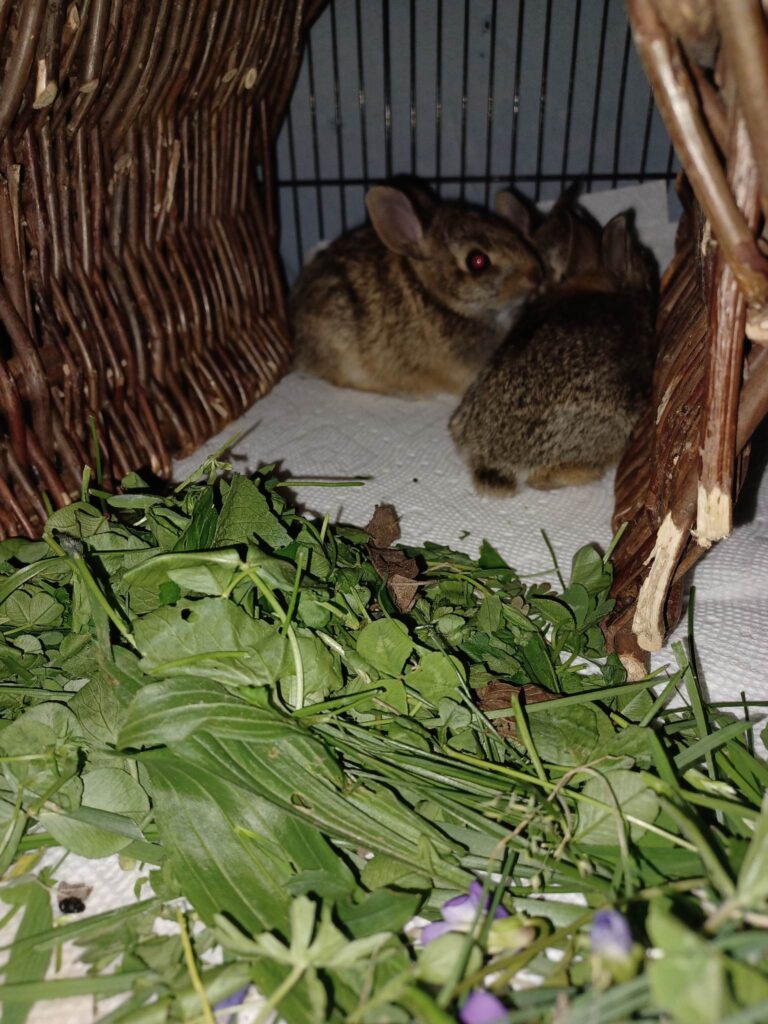
Bunnies!
The bunnies keep coming in, caught by cats or dogs. The ones that arrived last week have quickly graduated from milk replacer to clover, grass, plantain, dandelion and violet leaves which I serve in ample quantities.
I moved them to a large cage where they eat, poop, drink a little water, and hide.
I have two smaller babies still in the incubator getting milk replacer twice a day. This year I am using a goat milk replacer for them.
Rabbit research
Each year more research is being done by rabbit rehabilitators and we are working out better protocols for feeding and medicating.
I am prophylactically treating for coccidia, an intestinal protozoa that is found in your basic bunny gut. Stress, such as being caught by an animal, handled by humans, or driven in a car, can cause an overgrowth that quickly debilitates the rabbit’s system.
By treating prophylactically-that is, before symptoms develop- I am hoping to get ahead of any stress related diarrhea.
The ones in my care have all received this medicine and a nutritious, appropriate diet (NOT iceberg lettuce and carrots!) and I handle them as little as possible. Rabbit mothers visit the nest once or twice a day to feed their babies, so too much contact can exacerbate the stress they already have from strange food and quarters.
They are all doing well! Hooray for good news.
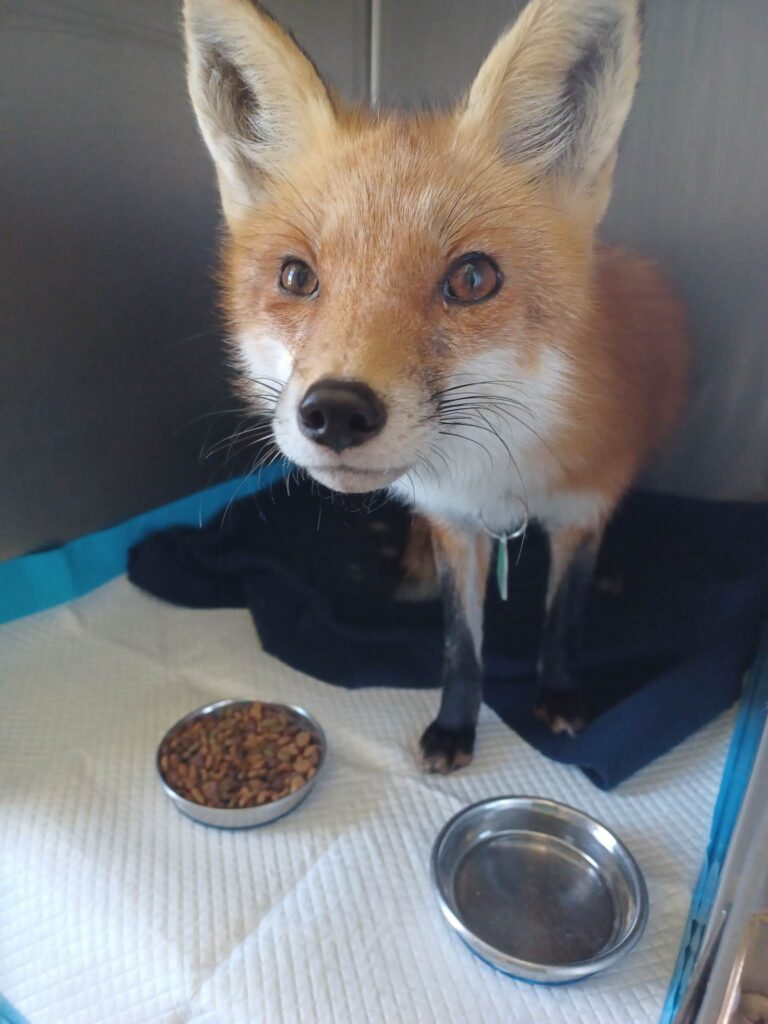
Foxy Lady
Miss Fox is still with me and I am still searching for the answer to her behavior. She isn’t afraid of people, submits to examinations, and shows no signs of fear.
What is going on with her?
It’s not this and it’s not that
She’s been cleared for rabies and distemper and has received vaccinations for both. Her poop shows no sign of parasites. She’s negative for toxoplasmosis, which in the United Kingdom causes something called “Dopey Fox Syndrome”.
The finders swore up and down that she wasn’t a pet even though that was my initial assumption. I consulted other rehabbers and they sent me looking for a medical reason for her behavior. I had thorough blood work done and she’s perfectly healthy as far as that’s concerned.
All she wants to eat, despite being offered foods a fox should love like blueberries, is dry cat food and mice.
Many wonderful people donated to a special fundraiser for her so we can solve this medical riddle or get her placed as an education animal.
I will keep everyone updated on her! In the meantime she is safe and well cared for.




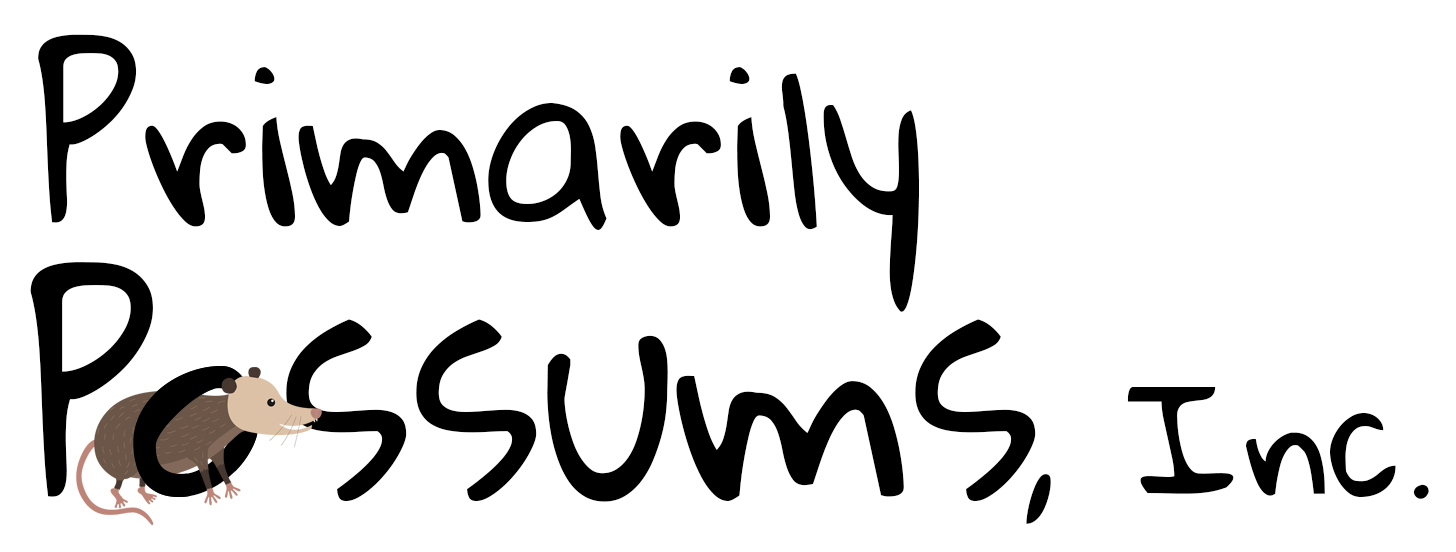
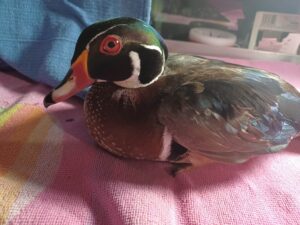
 2025 Sabbatical
2025 Sabbatical